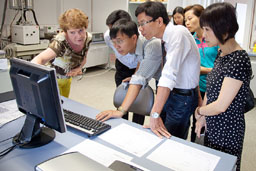![Workshop mit Prof. David Muir Wood (am Tisch hinten links) am Institut für Geotechnik. [Foto: Silvio Gesellmann]](http://baublog.file1.wcms.tu-dresden.de/wp-content/uploads/2015/10/20151013_Workshop-300x200.jpg)
In zwei weiteren öffentlichen Vorträgen wird Professor Muir Wood, der einer der berühmtesten Professoren im Bereich der Bodenmechanik weltweit ist, einen Einblick in seine Arbeit geben. Der erste Vortrag ist mehr fachspezifisch für die
Bodenmechanik, der zweite Vortrag ist für ein breiteres Publikum von Bauingenieurwesen gedacht.
Intermediate scales, critical states and testing of soils
27.10., 16:40 Uhr, NEU/101
Abstract:
Soils are usually treated as continua for the purposes of analysis of behaviour of geotechnical prototypes but their mechanical behaviour is the consequence of their particulate nature: we have to be aware of the particle-continuum duality. The space between the particles of a soil leads to the volume changes during compression and shear which distinguish soils from other civil engineering materials. Studies of the behaviour of mixtures of gravel and clay show clay domination of response until rather high proportions of the gravel force interaction between neighbouring particles.
Experimental observations of the formation of failure mechanisms in soils and of the transfer of stress through particle contacts reveal a number of intermediate scales – larger than typical particle sizes – which might be used to define the appropriate dimensions of representative volumetric elements. These turn out to be surprisingly large.
Continued shearing of granular materials tends eventually towards asymptotic states (critical states) in which stresses and density become stationary while shearing continues. For a truly asymptotic state to be reached it is evident that the grading and the shape of the particles
should also reach a stationary state. Introducing a grading index as a state variable the effects of particle crushing or particle erosion can be incorporated into simple constitutive models. An evolving shape index can also be introduced – particle shape will also have an influence on the properties of the soil.
Rooting for sustainable performance
28.10., 16:40 Uhr, BEY/67
Abstract:
The qualitative benefit of using vegetation to stabilise slopes has been well known for centuries. Quantitative description of the interaction of roots with granular soils is now possible. Extensive experimental investigation of the interaction of flexible fibres and granular soils
provides inspiration for the development of continuum models for the mechanical behaviour and pre-failure deformation of such fibre/soil mixtures. The deduced mechanisms of response are expected to be relevant also for soils containing flexible plant roots. As the soil-fibre mixture deforms, tensile strains in the soil generate stresses in favourably oriented fibres which resist the deformation and increase stiffness and strength. Two features are particularly important: the distribution of orientations of fibres and the allowance for the volume of void space not only occupied but also influenced by the presence of the fibres. Simulations of the response of such mixtures are compared with available experimental observations.

